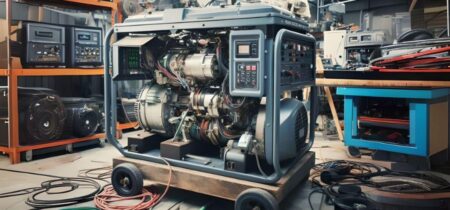
Before we figure out How Many BTUs A 22 kW Generator has, we must know what BTU and kW are. British Thermal Units (BTU) and Kilowatts (kW) are pivotal units in the realm of energy and power, each signifying distinct aspects of energy measurement and usage.
BTU stands for British Thermal Unit – one of the traditional units of heat. This is measured as the amount of heat needed to raise one pound of liquid water by one degree at a point when water is highly dense or about 39° F. It has an output of about one candle power, which corresponds approximately to the energy in burning a match.
In the past, it was used as a part of the British Imperial measurements system that is applied globally with particular consideration for the US. However, it mainly evaluates energy and rates such devices as gas stove burners, ovens, furnaces, heat pumps, and electric air-conditioning machines. It, however, proves to be highly important in estimating the heat loss as well as gain, especially when rating the efficiency of air-conditioning or heating systems.
Alternatively, a kilowatt (kW), one of the units of measurement in the International System of Units, stands for electric power where 1 kW is equal to 1,000 watts. Watt measures energy in one second. Therefore, a kW represents the rate at which energy is consumed or produced. At the rate of about 1.29 horsepower, it acts as a beam of power.
kW is commonly employed to denote the rated power for many types of engines, electric motors, tools, machines, and heaters. This is especially applicable in locations where power consumption, production, or flow are critical factors.
The BTU and kW measurements are important as they help one to understand or manage energy consumption in different equipment and activities. However, BTU concentrates on heat energy while KW focuses more on electrical applications in machinery and systems. This is what makes these measuring and controlling units precise as energy consumption has been effectively channeled through several fields.
How to Calculate the BTU Output of a 22 kW Generator?
To calculate the BTU output of a 22 kW generator, you’ll first need to understand the
conversion factor between kilowatts (kW) and British Thermal Units (BTU).
The conversion factor commonly used is 1 kW = 3412.142 BTU.
Here’s the formula and the steps to convert kW to BTU:
- Formula: BTU/hr = kW * Conversion Factor
- Conversion Factor: 1 kW = 3412.142 BTU
Now, let’s apply this formula to a 22 kW generator:
- Power of Generator in kW: 22 kW
- Conversion Factor: 3412.142 BTU
So, the calculation would be:
BTU output = 22 kW * 3412.142 BTU/kW = 75,067.124 BTU/hr
This result indicates that a 22 kW generator produces 75,067.124 BTU of energy per
hour.
For further assistance with these conversions, there are numerous online tools and
resources available:
- LearnMetrics
- RapidTables
- UnitConverter
- Maxtables
- Calculatorology
If you wish to compare a 22 kW generator’s energy output with other appliances, get a grip on what BTU or British Thermal Unit is all about. Think of BTU as the energy you need to heat up a pound of water by just 1 degree Fahrenheit. It’s like the universal yardstick for figuring out how much heat and energy stuff like appliances pump out.
How to Compare the BTU Output of a 22 kW Generator with Other Devices and Appliances?
To convert the wattage of an appliance to BTUs per hour, multiply the voltage (in volts) by the current (in amps) to get the wattage, then divide this number by 3.413. For example, a device with a wattage of 320 watts would have a BTU output of approximately 93.76 BTUs per hour. To find the total BTU output over a period, multiply the BTUs per hour by the number of hours the device runs.
For gas-powered appliances, you can find their BTU rating on a sticker or nameplate. This rating measures the thermal energy output of the appliance.
Here are examples of BTU outputs in common appliances:
Air Conditioners: An air conditioner’s BTU rating reveals the amount of heat it extracts per hour of operation. This range changes depending on the size of the room or area being catered for. Smaller systems having lower BTU/h are effective for small houses or one room while bigger places require high levels of BTU/h.
Heaters and Furnaces: Like air conditioners, heating devices, and furnaces are also rated in BTUs to indicate they can accommodate different space sizes. The BTU measurement helps identify a system capable of properly heating an individual space.
Fireplaces: Adequate heating requires sufficient BTU output in an open or vented fireplace. It could be insufficient for warming the home in case there are too few BTUs produced. On the contrary, a very high BTU output may render the room too hot.
Boilers: The number of windows, doors, and insulation levels within a home affects BTU capacity in boilers too. A lower BTU range may suffice in warm climates.
Grills and Stoves: BTU rating is commonly used for propane grills and gas stoves and it means that they indicate how much energy they release. On average a stove burner requires around 7,000 BTUs per hour but its capacity depends upon whether it is used for simmering or rapid boiling among others.
Comparing these appliances to a 22 kW generator in terms of BTU output involves
first converting the generator’s wattage to BTUs. A 22 kW generator equals 22,000
watts. Dividing this by 3.413 gives a BTU output of approximately 64,430 BTUs per
hour.
By understanding these conversions and the BTU requirements of different spaces
and appliances, you can effectively compare and assess the suitability of a 22 kW
generator against other devices.
How to use the BTU Output of a 22 kW Generator for Various Purposes and Scenarios
A 22 kW generator, equivalent to 75,064 BTU/hr, can be used for different purposes.
Here’s a detailed look at some of these applications:
For Home Use
Whole House Backup Power: For residential emergency power needs, a 22 kW generator could supply power to all of one’s home. It detects a blackout promptly and brings back energy to the whole house within twenty-five seconds.
Powering Multiple Appliances: These devices can control up to four air conditioners as well as manage eight additional external loads like hot water heaters, well pumps, or electric ranges using Smart Management Modules.
Quality Power Supply: The generators feature True Power technology that gives the same standard type of quality power as those utilized in the supply utilities appropriate for use on motors, appliances, and sensitive electronics.
Compact and Quiet Operation: They are more feasible in residential environments because their designs are lower than the standard central A/C unit and noise levels.
For Business Use
Powering Business Operations: Businesses can use a 22 kW generator to power essential equipment during outages, ensuring continuity of operations.
Backup for Critical Systems: For businesses with critical systems like servers or refrigeration units, the quick response and reliable power supply of these generators are necessary.
For Recreational Vehicles (RVs)
Powering RV Appliances: A 22 kW generator can easily power an RV’s air conditioning, refrigerator, and other appliances simultaneously.
Extended Off-Grid Capability: With the efficient fuel consumption of these generators, RV users can extend their off-grid adventures without worrying about power shortages.
Using a 22 kW generator for backup power, heating, and cooling offers several
benefits and challenges:
Advantages and Disadvantages of
Advantages
Emergency Power: It is an alternative source of energy meant for use in times of blackout. It ensures continuity of operation of vital equipment.
Value Addition: Such a generator is also easy to install and it almost always enhances the market value of the home.
Instant Power Switching: These generators will immediately shift from grid power to backup power and supply all your house with electric energy within 30 seconds only.
Emergency Power: With an installed battery backup system, it will operate as a generator to supply the home’s emergency needs during blackouts so that the vital appliances and home systems continue working.
Value Addition: The installation of this generator frequently increases the cost of your house.
Instant Power Switching: The generators switch instantly from grid power to backup power and restore your whole house within 30 seconds.
Fuel Efficiency: The 22kW power consumes less fuel compared to other larger ones and is hence cost-effective to run it down.
Whole-Home Power Management: You can even power your whole house, operate four ACs, and load some other equipment such as water heaters, electric ranges, etc.
High-Quality Power Supply: They produce utility-grade power that has insignificant distortion and is therefore perfect for sensitive electronics.
Size and Noise Level: Compact with the residential appearance and less noisy compared to the common household central air conditioning unit. Disadvantages
High Initial Cost: The upfront cost of a 22 kW generator is higher than that of portable generators.
Yearly Maintenance: Regular maintenance is required to keep the generator in optimal condition.
Installation Requirements: A professional installation is usually required, with possible space constraints dictated by many considerations.
Size Determination: To find out whether a 22kW generator is the correct size of a generator, you must measure your house’s electrical load at an accurate level. This involves estimating the energy requirement of all appliances and gadgets that are on standby during a power outage.
Fuel Type Considerations: The selection of natural gas or propane influences the size and the power generation capability of a generator. Natural gas generators usually provide higher power, though demand bigger pipelines.
Climate Impact: When it comes to powering heating and cooling facilities in areas that have extremely hot weather conditions, a bigger generator is highly advisable.
Choosing the Right Installer: Safety as well as compliance to local regulations demands that one chooses an experienced as well as licensed electrician for the installation work.
Frequently Asked Questions
How much gas does a Generac 22kW generator use?
The fuel consumption of a Generac 22kW generator varies depending on the load and the type of fuel used. For propane, a typical 22kW Generac standby generator consumes about 2.1 gallons per hour at half load and up to 3.6 gallons per hour at full load. In terms of natural gas consumption, a 22 kW Generac generator burns through approximately 9.7 cubic meters of natural gas at full load, which translates to about 203 cubic feet of natural gas per hour.
How many BTUs is a 20kW generator?
A 20 kW generator produces approximately 68,240 BTUs per hour.
How much can a 22 kW generator power?
A 22 kW generator can power a normal-sized house, typically around 3,000 to 4,000 square feet, running major appliances like washing machines, ovens, and HVAC systems simultaneously. It can be fueled by diesel, propane, or natural gas, and is suitable for extended use.









